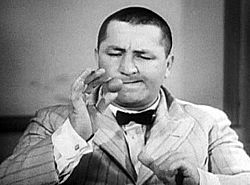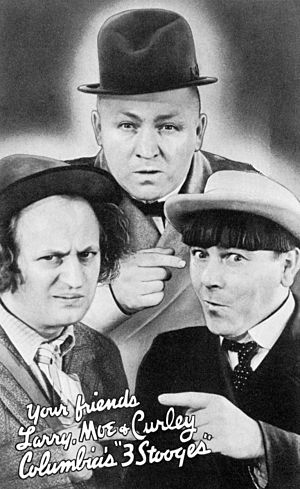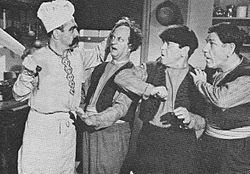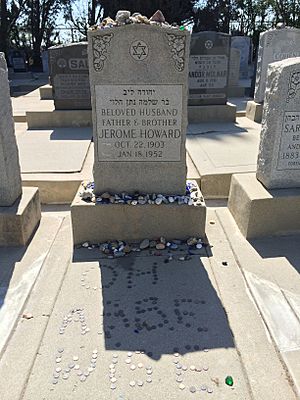Curly Howard facts for kids
Quick facts for kids
Curly Howard
|
|
|---|---|

Curly Howard in Disorder in the Court
|
|
| Born |
Jerome Lester Horwitz
October 22, 1903 |
| Died | January 18, 1952 (aged 48) San Gabriel, California, U.S.
|
| Cause of death | Cerebral hemorrhage |
| Resting place | Home of Peace Cemetery, East Los Angeles, California, U.S. |
| Other names | Jerry Howard Jerome Howard |
| Occupation | Comedian, actor |
| Years active | 1918–1947 |
| Height | 5 ft 5 in (1.65 m) |
| Spouse(s) |
|
| Children | 2 |
| Relatives | Moe Howard (brother) Shemp Howard (brother) Joan Howard Maurer (niece) |
Jerome Lester Horwitz (born October 22, 1903 – died January 18, 1952), known as Curly Howard, was an American comedian and actor. He was famous for being a member of the comedy group, the Three Stooges. His older brothers, Moe and Shemp Howard, were also in the group, along with actor Larry Fine.
Curly was often seen as the most popular and easiest to recognize of the Stooges. He was known for his funny, high-pitched voice and sounds like "nyuk-nyuk-nyuk!" and "woob-woob-woob!". He also made barking sounds like a dog and said "soitenly!" (meaning certainly). Curly was great at physical comedy, like falling and spinning on the ground. He was also good at making things up on the spot and was very athletic.
Curly had to leave the Three Stooges in 1946 because of a serious stroke. This ended his career in show business. He had many health problems and more strokes until he passed away in 1952 at the age of 48.
Contents
Early Life of Curly Howard
Curly Howard was born Jerome Lester Horwitz in Bensonhurst, a part of Brooklyn in New York City. His birthday was October 22, 1903. He was the youngest of five brothers. Because he was the youngest, his brothers called him "Babe" as a playful nickname.
The name "Babe" stayed with him for a long time. But when his older brother Shemp Howard married someone also nicknamed "Babe," they started calling him "Curly" to avoid confusion. His full formal Hebrew name was "Yehudah Lev ben Shlomo Natan ha Levi."
Curly was a quiet child and didn't cause much trouble for his parents. He wasn't the best student, but he was a great athlete on his school's basketball team. He didn't finish high school. Instead, he worked different small jobs and always looked up to his older brothers. He was also a talented ballroom dancer and singer.
When Curly was 12, he accidentally shot himself in his left ankle while cleaning a rifle. Moe quickly took him to the hospital, which saved his life. The injury made his left leg thinner and caused a slight limp. He was so scared of surgery that he never had it fixed. When he performed with the Stooges, he created his famous exaggerated walk to hide his limp on screen.
Curly loved music and comedy. He would watch his brothers Shemp and Moe perform in Ted Healy's vaudeville show. He often hung out backstage but didn't join their acts at first.
Curly's Prime Years as a Comedian
Curly's childlike actions and natural funny charm made him very popular with audiences, especially children. In his acts, he was known for having an "indestructible" head. This meant his head always won, breaking anything that hit it, even saws! He would then famously say, "Oh, look!" Even though he never had formal acting lessons, his comedy skills were amazing.
Many times, directors would just let the camera roll. They would let Curly make things up as he went along. Jules White, one of the directors, would even leave empty spaces in the Stooge scripts. This allowed Curly to improvise for several minutes. White later said, "If we wrote a scene and needed a little something extra, I'd say to Curly, 'Look, we've got a gap to fill this in with a "woob-woob" or some other bit of business.' And he never disappointed us."
By the late 1930s, the Stooges' films were mostly about Curly's wild and funny performances. Classic films like A Plumbing We Will Go (1940) and An Ache in Every Stake (1941) showed how he could turn everyday items into funny props. Moe later shared that if Curly forgot his lines, he would just improvise. This allowed the scene to continue without stopping. Moe said, "If we were going through a scene and he'd forget his words for a moment... you never knew what he was going to do. On one occasion he'd get down to the floor and spin around like a top until he remembered what he had to say."
Curly also created many reactions and expressions. The other Stooges would often copy these even after he left the group.
- "Nyuk, nyuk, nyuk" – This was Curly's funny laugh, often with quick finger-snapping.
- "Woob, woob, woob!" – He used this when he was scared, confused, or flirting.
- "Hmmm!" – A quiet, high-pitched sound showing interest, excitement, or even anger.
- "Nyahh-ahhh-ahhh!" – A scared reaction, which the other Stooges often used later.
- "Laaa-Deeeeeee" or "Laaa, laaa, laaa" – Curly's working "song," also used when he acted innocent.
- "Ruff Ruff" – A dog bark, used to playfully push an enemy or bark at an attractive person.
- "Ha-cha-cha-cha-cha!" – A less common expression, like Jimmy Durante's famous call.
- "I'm a victim of soicumstance [circumstance]" – A funny way of saying he was a victim of circumstances.
- "Soiteny!" – His way of saying "certainly."
- "Huff huff huff!" – Short, quick breaths from excitement or to annoy someone.
- "Ah-ba-ba-ba-ba-ba-ba!" – A high-pitched, silly yelling sound he used later in his career when scared or very excited.
- "Indubitably" – An expression he used to sound smart.
- Curly's teeth would chatter nervously, making a sound like a small hammer hitting a chisel.
- "A WISE Guy, Eh?" – His annoyed response.
- "Oh Look!" – A surprised comment, usually about something common.
- "Say a coupla adjectives!" – He would say this to another Stooge who was hurt, usually Moe.
- Sometimes, when the Stooges needed to think hard, Curly would bang his head on a wall. Then he would shout, "I got it! I got it!" Moe would ask, "What have you got?" Curly's answer: "A terrific headache."
Later Life and Passing
In December 1951, the hospital where Curly was staying said he was becoming difficult for the nurses. They suggested he move to a different type of care facility. Moe refused and moved him to the Baldy View Sanitarium in San Gabriel, California.
On January 7, 1952, Moe was called from the film set to help move Curly one last time. Eleven days later, on January 18, Curly passed away. Curly lived the shortest life of the Stooges, dying at 48 years old. He had a Jewish funeral and was buried at the Home of Peace Cemetery in East Los Angeles. Curly's older brothers, Benjamin and Shemp, and his parents, Jennie and Solomon, are also buried there.
Curly Howard's Legacy
Many fans and critics believe Curly Howard was their favorite member of The Three Stooges. In 1972, Larry Fine remembered, "Personally, I thought Curly was the greatest because he was a natural comedian who had no formal training. Whatever he did, he made up on the spur of the moment. When we lost Curly, we took a hit." Curly's actions, behavior, and personality, along with his famous phrases like "n'yuk, n'yuk, nyuk," "woob, woob, woob," and "soitenly!" have become a part of American popular culture. Steve Allen called him one of the "most original, yet seldom recognized, comic geniuses."
In 2000, Mel Gibson, a big fan of the Stooges, produced a television film for ABC. The film was about the lives and careers of the Stooges. In an interview about the film, Gibson said Curly was his favorite Stooge. In the movie, Michael Chiklis played Curly.
In the 2012 Farrelly brothers' film The Three Stooges, Will Sasso played the adult Curly. Robert Capron played Young Curly.
In the children's book series Captain Underpants and its movie, the elementary school where the main characters go is named Jerome Horwitz Elementary School. This is a reference to Curly Howard's birth name.
Filmography
Features
- Turn Back the Clock (1933)
- Broadway to Hollywood (1933)
- Meet the Baron (1933)
- Dancing Lady (1933)
- Myrt and Marge (1933)
- Fugitive Lovers (1934)
- Hollywood Party (1934)
- The Captain Hates the Sea (1934)
- Start Cheering (1938)
- Time Out for Rhythm (1941)
- My Sister Eileen (1942)
- Good Luck, Mr. Yates (1943) (scenes deleted, reused in Gents Without Cents)
- Rockin' in the Rockies (1945)
- Swing Parade of 1946 (1946)
- Stop! Look! and Laugh! (1960) (scenes from Stooge shorts)
Short subjects
- Nertsery Rhymes (1933)
- Beer and Pretzels (1933)
- Hello Pop! (1933)
- Plane Nuts (1933)
- Roast Beef and Movies (1934)
- Jail Birds of Paradise (1934)
- Hollywood on Parade # B-9 (1934)
- Woman Haters (1934) (*credited as "Curley")
- The Big Idea (1934)
- Punch Drunks (1934)
- Men in Black (1934)
- Three Little Pigskins (1934)
- Horses' Collars (1935)
- Restless Knights (1935)
- Screen Snapshots Series 14, No. 6 (1935)
- Pop Goes the Easel (1935)
- Uncivil Warriors (1935)
- Pardon My Scotch (1935)
- Hoi Polloi (1935)
- Three Little Beers (1935)
- Ants in the Pantry (1936)
- Movie Maniacs (1936)
- Screen Snapshots Series 15, No. 7 (1936)
- Half Shot Shooters (1936)
- Disorder in the Court (1936)
- A Pain in the Pullman (1936)
- False Alarms (1936)
- Whoops, I'm an Indian! (1936)
- Slippery Silks (1936)
- Grips, Grunts and Groans (1937)
- Dizzy Doctors (1937)
- Three Dumb Clucks (1937)
- Back to the Woods (1937)
- Goofs and Saddles (1937)
- Cash and Carry (1937)
- Playing the Ponies (1937)
- The Sitter Downers (1937)
- Termites of 1938 (1938)
- Wee Wee Monsieur (1938)
- Tassels in the Air (1938)
- Healthy, Wealthy and Dumb (1938)
- Violent Is the Word for Curly (1938)
- Three Missing Links (1938)
- Mutts to You (1938)
- Flat Foot Stooges (1938)
- Three Little Sew and Sews (1939)
- We Want Our Mummy (1939)
- A Ducking They Did Go (1939)
- Screen Snapshots: Stars on Horseback (1939)
- Yes, We Have No Bonanza (1939)
- Saved by the Belle (1939)
- Calling All Curs (1939)
- Oily to Bed, Oily to Rise (1939)
- Three Sappy People (1939)
- You Nazty Spy! (1940)
- Screen Snapshots: Art and Artists (1940)
- Rockin' thru the Rockies (1940)
- A Plumbing We Will Go (1940)
- Nutty but Nice (1940)
- How High Is Up? (1940)
- From Nurse to Worse (1940)
- No Census, No Feeling (1940)
- Cookoo Cavaliers (1940)
- So Long Mr. Chumps (1941)
- Dutiful but Dumb (1941)
- All the World's a Stooge (1941)
- I'll Never Heil Again (1941)
- An Ache in Every Stake (1941)
- In the Sweet Pie and Pie (1941)
- Some More of Samoa (1941)
- Loco Boy Makes Good (1942)
- What's the Matador? (1942)
- Cactus Makes Perfect (1942)
- Matri-Phony (1942)
- Three Smart Saps (1942)
- Even as IOU (1942)
- Sock-a-Bye Baby (1942)
- They Stooge to Conga (1943)
- Dizzy Detectives (1943)
- Spook Louder (1943)
- Back from the Front (1943)
- Three Little Twirps (1943)
- Higher Than a Kite (1943)
- I Can Hardly Wait (1943)
- Dizzy Pilots (1943)
- Phony Express (1943)
- A Gem of a Jam (1943)
- Crash Goes the Hash (1944)
- Busy Buddies (1944)
- The Yoke's on Me (1944)
- Idle Roomers (1944)
- Gents Without Cents (1944)
- No Dough Boys (1944)
- Three Pests in a Mess (1945)
- Booby Dupes (1945)
- Idiots Deluxe (1945)
- If a Body Meets a Body (1945)
- Micro-Phonies (1945)
- Beer Barrel Polecats (1946)
- A Bird in the Head (1946)
- Uncivil War Birds (1946)
- The Three Troubledoers (1946)
- Monkey Businessmen (1946)
- Three Loan Wolves (1946)
- G.I. Wanna Home (1946)
- Rhythm and Weep (1946)
- Three Little Pirates (1946)
- Half-Wits Holiday (1947)
- Hold That Lion! (1947, cameo appearance)
- Malice in the Palace (1949, cameo appearance filmed but not used)
- Booty and the Beast (1953, recycled footage from Hold That Lion!)
Images for kids
See also
 In Spanish: Curly Howard para niños
In Spanish: Curly Howard para niños







